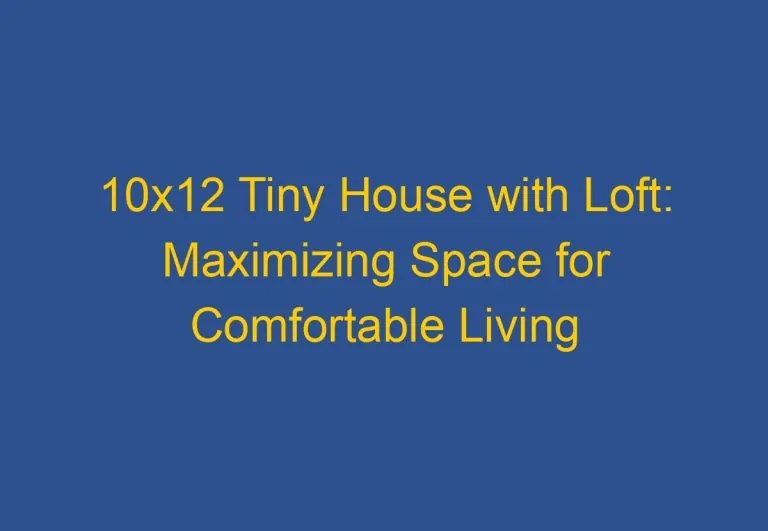Tiny House Area: The Pros and Cons of Living in a Small Space
Tiny houses have become increasingly popular in recent years, as people look for ways to downsize their living space and simplify their lives. These small homes offer a stylish and affordable alternative to traditional houses, and they can be found in communities all over the country. In this article, we’ll take a closer look at the concept of a tiny house area, exploring what it is and why it’s becoming so popular.
A tiny house area is a community designed specifically for people who want to live in small homes. These areas can be found in both urban and rural locations, and they offer a range of amenities and services to residents. Some tiny house areas are designed for permanent residents, while others are geared towards vacationers or people who want to try out tiny house living before committing to it full-time.
One of the main benefits of living in a tiny house area is the sense of community that it provides. Because everyone is living in a small space, there is a greater sense of camaraderie and connection between residents. Additionally, many tiny house areas offer shared amenities like community gardens, laundry facilities, and recreational spaces, which can help foster a sense of community and make it easier for residents to socialize and get to know one another.
Design and Features
When it comes to designing a tiny house, every inch of space counts. Maximizing space is essential to ensure that the tiny house is functional and comfortable to live in. There are a few key design features that can help achieve this goal.
Maximizing Space
One of the most popular design features in tiny houses is the use of high ceilings and lofts. This allows for additional living space without taking up valuable floor space. Sleeping lofts are a common feature in tiny houses, and they can be designed to be cozy and comfortable.
Another way to maximize space is through the use of multifunctional furniture. For example, a sofa bed can serve as both a place to sit and a place to sleep. A table that folds down when not in use can create additional space in the living area.
Essential Amenities
Despite their small size, tiny houses can still have all the essential amenities that one would expect in a larger home. This includes a kitchen, bathroom, and living room. When designing a tiny house, it’s important to consider the size and layout of each of these areas.
In the kitchen, it’s important to choose appliances and fixtures that are appropriately sized for the space. A compact refrigerator, two-burner stove, and small sink can provide all the functionality needed in a tiny house kitchen.
In the bathroom, a wet bathroom design can help maximize space. This involves combining the shower and toilet space into one. A composting toilet can also be a good option for a tiny house.
Aesthetic and Style
Finally, the aesthetic and style of a tiny house are important considerations. While tiny houses are often designed to be functional and practical, they can also be stylish and aesthetically pleasing. This can be achieved through the use of color, texture, and materials.
For example, a tiny house with a rustic style might incorporate reclaimed wood into the design. A modern tiny house might feature sleek and minimalist design elements. Ultimately, the style of the tiny house should reflect the personality and preferences of its owner.
Overall, designing a tiny house requires careful consideration of space, functionality, and style. By maximizing space, incorporating essential amenities, and choosing a style that reflects the owner’s personality, a tiny house can be both practical and beautiful.
Legalities and Logistics
Zoning and Building Codes
When it comes to tiny houses, one of the most important considerations is zoning and building codes. These regulations vary depending on the location, so it’s important to research the rules in your area before building or parking a tiny house. In some areas, there may be specific zoning requirements for tiny houses, while in others, they may be considered as accessory dwelling units (ADUs) and subject to the same regulations as other residential structures.
It’s also important to ensure that the tiny house complies with building codes to ensure safety and structural integrity. Some states have adopted specific codes for tiny houses, while others may require them to meet the same standards as traditional homes. It’s essential to do your research and consult with local authorities to ensure compliance with all relevant codes and regulations.
Towing and Transportation
Another important consideration when it comes to tiny houses is towing and transportation. If you plan to move your tiny house frequently, it’s essential to ensure that it is designed to be towed safely. This may require a specific tow vehicle and may also require a special permit for oversized loads.
It’s also important to consider the logistics of towing and transportation. For example, some areas may have restrictions on when oversized loads can be transported, and it’s essential to plan your route carefully to avoid low bridges, narrow roads, and other obstacles.
Placement and Communities
Finally, when it comes to tiny houses, placement and communities are also important considerations. Some areas may have specific regulations regarding where tiny houses can be parked or placed, while others may have tiny house communities where residents can live and park their homes.
It’s essential to research all options carefully before deciding where to park or place your tiny house. This may involve contacting local authorities, researching available tiny house communities, or even purchasing property to park your tiny house on.
Overall, when it comes to legalities and logistics, it’s essential to do your research, consult with local authorities, and ensure compliance with all relevant regulations and codes. By taking these steps, you can ensure a safe and legal experience when it comes to tiny house living.
Frequently Asked Questions
What are the typical dimensions of a tiny house on wheels?
Tiny houses on wheels typically range from 80 to 400 square feet. The average size of a tiny house on wheels is around 200 square feet. The height of a tiny house on wheels is typically between 8 and 13 feet, and the width is usually between 8 and 10 feet.
How does the average size of a stationary tiny house compare to one on wheels?
Stationary tiny houses are generally larger than those on wheels, ranging from 400 to 1,000 square feet. The size of a stationary tiny house is limited by the zoning regulations of the area in which it is located.
What are the zoning regulations for tiny houses in urban areas of California?
The zoning regulations for tiny houses in urban areas of California vary depending on the local government’s policies. In some areas, tiny houses on wheels are allowed as ADUs (accessory dwelling units) on residential properties. In other areas, tiny houses on wheels are not allowed at all.
Where can I find tiny house communities for seniors?
There are several tiny house communities for seniors located throughout the United States. Some of the most popular communities include the Tiny House Village at Mt. Hood in Oregon and the NOLA Tiny House Village in Louisiana.
Are there any permanent tiny home communities with shared amenities?
Yes, there are several permanent tiny home communities with shared amenities located throughout the United States. These communities typically offer shared amenities such as laundry facilities, community gardens, and recreation areas.
What constitutes a tiny house in terms of maximum square footage?
A tiny house is generally considered to be a home that is less than 400 square feet in size. However, some local governments have different size requirements for tiny houses, so it is important to check the zoning regulations in your area.










